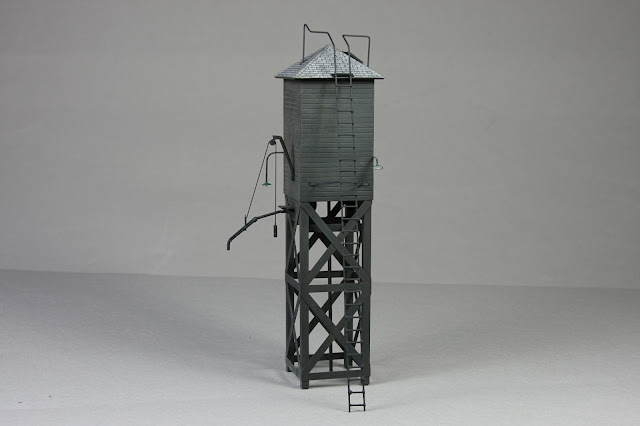The sanding tower is seen standing in the background of the photo below I took in the late 1970's.
This is another one of the structures in Danbury yard that was never the focus of my attention at that time that I regret today for not photographing or measuring when it was still possible. It is my understanding that the tower just collapsed one day, I believe that occured in the 1980's.
Modeling
To build an accurate model as possible of this sand tower I had to rely on the few photos that could be found and the one above for reference. Thankfully there is one photo that has a locomotive near the tower, knowing the dimensions of that type of loco gives a hint of how tall the tower was and the track gauge helps with the tower width, so I went with the sizing information derived from the 1957 W. T. Clynes photo below to build the model.
W. T. Clynes Photo
A second support post and cross braces are glued in place next.
Before the solvent cement is completely cured, a quick check to make sure the side stands plumb.
With two sides built, X bracing is added as per prototype.
Two additional sand storage box sides and X bracing bring the four sides together, a top and bottom of the storage box are glued inside to keep the structure square.
The pyramid hip roof sides are being glued together in the photo below. The grid lines on the cutting mat and a perpendicular straight edge keep things square while glue cures.
Below the roof is glued in place. A sand distribution hose and support pulley that were left over brass parts from the steel sanding tower that was built with the Electric Service Group of structures are added.
Phosphor bronze wire is used to make the roof access ladder.
The most difficult part of the ladder to make were the bends for the hand rails on the roof. Each side rail of the ladder is one continuous length of wire from bottom to top. A brass bar stock support brace was added to the ladder and attached to the side of the storage box.
This must have been an interesting climb on the prototype!
The early 1950's photo below was useful for painting the model.
The finished sanding tower ready for the layout.














Great work as usual - thanks for sharing!
ReplyDeleteJoe,
ReplyDeleteVery nice work on the tower, and once again I learned something new. This time it was your tip about using the cutting grid for glue up alignment. Simple but ingenious.
Thanks
Ryan